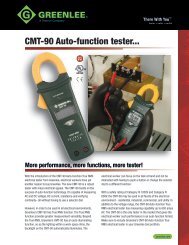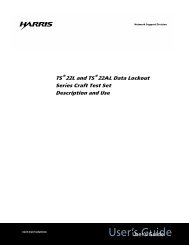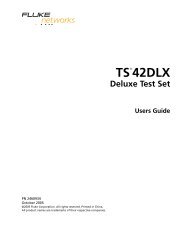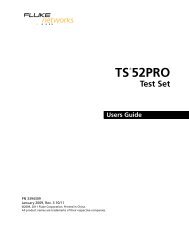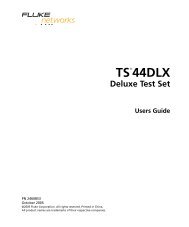TS23 Pro Manual - Datacomtools
TS23 Pro Manual - Datacomtools
TS23 Pro Manual - Datacomtools
Create successful ePaper yourself
Turn your PDF publications into a flip-book with our unique Google optimized e-Paper software.
TS 23 PRO<br />
Test Set<br />
Users Guide<br />
PN 3988070<br />
August 2011, Rev. 1, 12/11<br />
©2011 Fluke Corporation. Printed in China.<br />
All product names are trademarks of their respective companies.
LIMITED WARRANTY AND LIMITATION OF LIABILITY<br />
Each Fluke Networks product is warranted to be free from defects in material and workmanship under<br />
normal use and service. The warranty period for the mainframe is 18 months and begins on the date of<br />
purchase. Parts, accessories, product repairs and services are warranted for 90 days, unless otherwise stated.<br />
Ni-Cad, Ni-MH and Li-Ion batteries, cables or other peripherals are all considered parts or accessories. The<br />
warranty extends only to the original buyer or end user customer of a Fluke Networks authorized reseller,<br />
and does not apply to any product which, in Fluke Networks’ opinion, has been misused, abused, altered,<br />
neglected, contaminated, or damaged by accident or abnormal conditions of operation or handling. Fluke<br />
Networks warrants that software will operate substantially in accordance with its functional specifications<br />
for 90 days and that it has been properly recorded on non-defective media. Fluke Networks does not warrant<br />
that software will be error free or operate without interruption.<br />
Fluke Networks authorized resellers shall extend this warranty on new and unused products to end-user<br />
customers only but have no authority to extend a greater or different warranty on behalf of Fluke Networks.<br />
Warranty support is available only if product is purchased through a Fluke Networks authorized sales outlet<br />
or Buyer has paid the applicable international price. Fluke Networks reserves the right to invoice Buyer for<br />
importation costs of repair/replacement parts when product purchased in one country is submitted for repair<br />
in another country.<br />
Fluke Networks warranty obligation is limited, at Fluke Networks option, to refund of the purchase price,<br />
free of charge repair, or replacement of a defective product which is returned to a Fluke Networks<br />
authorized service center within the warranty period.<br />
To obtain warranty service, contact your nearest Fluke Networks authorized service center to obtain return<br />
authorization information, then send the product to that service center, with a description of the difficulty,<br />
postage and insurance prepaid (FOB destination). Fluke Networks assumes no risk for damage in transit.<br />
Following warranty repair, the product will be returned to Buyer, transportation prepaid (FOB destination).<br />
If Fluke Networks determines that failure was caused by neglect, misuse, contamination, alteration, accident<br />
or abnormal condition of operation or handling, or normal wear and tear of mechanical components, Fluke<br />
Networks will provide an estimate of repair costs and obtain authorization before commencing the work.<br />
Following repair, the product will be returned to the Buyer transportation prepaid and the Buyer will be<br />
billed for the repair and return transportation charges (FOB Shipping point).<br />
THIS WARRANTY IS BUYER’S SOLE AND EXCLUSIVE REMEDY AND IS IN LIEU OF ALL OTHER WARRANTIES,<br />
EXPRESS OR IMPLIED, INCLUDING BUT NOT LIMITED TO ANY IMPLIED WARRANTY OR MERCHANTABILITY OR<br />
FITNESS FOR A PARTICULAR PURPOSE. FLUKE NETWORKS SHALL NOT BE LIABLE FOR ANY SPECIAL, INDIRECT,<br />
INCIDENTAL OR CONSEQUENTIAL DAMAGES OR LOSSES, INCLUDING LOSS OF DATA, ARISING FROM ANY<br />
CAUSE OR THEORY.<br />
Since some countries or states do not allow limitation of the term of an implied warranty, or exclusion or<br />
limitation of incidental or consequential damages, the limitations and exclusions of this warranty may not<br />
apply to every buyer. If any provision of this Warranty is held invalid or unenforceable by a court or other<br />
decision-maker of competent jurisdiction, such holding will not affect the validity or enforceability of any<br />
other provision.<br />
4/04-18<br />
Fluke Networks<br />
PO Box 777<br />
Everett, WA 98206-0777<br />
USA
Contents<br />
Title<br />
Overview of Features ..........................................................................................................................................1<br />
Registration .........................................................................................................................................................1<br />
Contacting Fluke Networks ................................................................................................................................1<br />
Safety Information ..............................................................................................................................................2<br />
Physical Characteristics .......................................................................................................................................3<br />
Housing ........................................................................................................................................................3<br />
Belt Clip ........................................................................................................................................................3<br />
Test Leads .....................................................................................................................................................3<br />
Battery ..........................................................................................................................................................3<br />
Speaker and Speakerphone Microphone ...................................................................................................3<br />
LED Indicators and Keypad .........................................................................................................................3<br />
How to Turn the Test Set On and Off ................................................................................................................9<br />
Automatic Power-Down .....................................................................................................................................9<br />
How to Use the Monitor and Talk Modes .........................................................................................................9<br />
Monitor Mode ..............................................................................................................................................9<br />
Talk Mode ....................................................................................................................................................9<br />
Low Voltage Lockout ...........................................................................................................................9<br />
Originating a Call ...............................................................................................................................10<br />
Disconnecting a Call ...........................................................................................................................10<br />
Answering a Call .................................................................................................................................10<br />
Ground Start .......................................................................................................................................10<br />
Data Safe Practices .....................................................................................................................................10<br />
Dialing and Storing Numbers in Memory ................................................................................................11<br />
Last Number Redial (LNR) ..................................................................................................................11<br />
<strong>Pro</strong>gram Speed Dialing Numbers ......................................................................................................11<br />
Putting a Pause in a Stored Number .................................................................................................11<br />
Storing the Number You are Calling .................................................................................................11<br />
Dialing a Number with the Speed Dial Function ..............................................................................11<br />
Configuring Your Test Set ................................................................................................................................12<br />
Hook Flash Duration ..................................................................................................................................12<br />
Test Set Timeout ........................................................................................................................................12<br />
Make Receive-Only Loud Speaker Mode the Default ..............................................................................12<br />
Factory Defaults .........................................................................................................................................12<br />
Maintenance .....................................................................................................................................................13<br />
Cleaning .....................................................................................................................................................13<br />
If the Test Set Stops Operating .................................................................................................................13<br />
Page<br />
i
<strong>TS23</strong> PRO Test Set<br />
Users Guide<br />
If the Test Set Gets Wet .............................................................................................................................13<br />
Replacing the Battery ................................................................................................................................13<br />
Replacing the Belt Clip ...............................................................................................................................14<br />
Replacing the Belt Clip <strong>Pro</strong>tector ..............................................................................................................14<br />
Replacing the Test Leads ...........................................................................................................................15<br />
Accessories ..................................................................................................................................................16<br />
Specifications .....................................................................................................................................................17<br />
Software Notice .................................................................................................................................................18<br />
ii
TS ® 23 PRO<br />
<strong>Pro</strong>fessional Series Test Set<br />
Overview of Features<br />
The <strong>TS23</strong> PRO <strong>Pro</strong>fessional Series Test Set is an analog<br />
test telephone used by installers, repair technicians and<br />
other authorized personnel to test copper wire, voice<br />
subscriber lines.<br />
The test sets include these features and functions:<br />
• Line voltage / Loop current test<br />
• Optional headset<br />
• DataSafe protection in Monitor mode<br />
• High impedance in Monitor mode<br />
• High voltage protection<br />
• Last number redial up to 23 digits<br />
• Microphone mute<br />
• Pause key<br />
• Reverse polarity indication<br />
• Two-way speakerphone<br />
• Receive-only loud speaker mode<br />
• Speed dialing for nine 23-digit numbers<br />
• Tone and pulse dialing<br />
• Hook flash<br />
• Low battery indication<br />
• Field-replaceable belt clips, battery, and test leads<br />
• Weatherproof case<br />
• High voltage lockout in Talk mode<br />
Registration<br />
Registering your product with Fluke Networks gives<br />
you access to valuable information on product updates,<br />
troubleshooting tips, and other support services. To<br />
register, fill out the online registration form on the<br />
Fluke Networks website at www.flukenetworks.com/<br />
registration.<br />
Contacting Fluke Networks<br />
www.flukenetworks.com<br />
support@flukenetworks.com<br />
+1-425-446-4519<br />
• Australia: 61 (2) 8850-3333 or 61 (3) 9329 0244<br />
• Beijing: 86 (10) 6512-3435<br />
• Brazil: 11 3759 7600<br />
• Canada: 1-800-363-5853<br />
• Europe: +31-(0) 40 2675 600<br />
• Hong Kong: 852 2721-3228<br />
• Japan: 03-6714-3117<br />
• Korea: 82 2 539-6311<br />
• Singapore: 65-6799-5566<br />
• Taiwan: (886) 2-227-83199<br />
• Anywhere in the world: +1-425-446-4519<br />
Visit the Fluke Networks website for a complete list of<br />
phone numbers.<br />
1
<strong>TS23</strong> PRO Test Set<br />
Users Guide<br />
Safety Information<br />
The following IEC symbols are used either on the test<br />
set or in the manual:<br />
<br />
<br />
<br />
<br />
<br />
<br />
<br />
Warning: Risk of personal injury. See the<br />
manual for details.<br />
Caution: Risk of damage or destruction to<br />
equipment or software. See the manual<br />
for details.<br />
Warning: Risk of electric shock.<br />
Conforms to relevant Australian EMC<br />
requirements.<br />
Conforms to relevant Canadian and US<br />
standards.<br />
Conforms to European Union directives.<br />
Double Insulated - does not require<br />
connection to earth ground.<br />
Do not put products containing circuit<br />
boards into the garbage. Dispose of circuit<br />
boards in accordance with local<br />
regulations.<br />
Warning<br />
To avoid possible fire, electric shock, or<br />
personal injury:<br />
• The test set meets IEC Measurement Category I.<br />
CAT I equipment is designed to protect against<br />
transients in equipment on circuits not directly<br />
connected to MAINS. Under no circumstances<br />
should the test leads of the test set be connected<br />
to any CAT II, CAT III, or CAT IV rated circuit.<br />
• Do not use test leads if they are damaged. Examine<br />
the test leads for exposed metal and damage to<br />
the insulation. Make sure the wear indicator on the<br />
cords does not show. The wear indicator is the<br />
white layer below the outer, braided layer. Verify<br />
the continuity of the test leads. To replace the test<br />
leads, see page 15.<br />
• Do not use the test set with the case open.<br />
• Do not use the test set if it operates incorrectly.<br />
• Do not connect the test set to voltages higher than<br />
the maximum specified by the Measurement<br />
Category (CAT) rating of the lowest-rated<br />
individual component of the test set, test leads, or<br />
accessory.<br />
• Use only a 9 V battery, correctly installed, to supply<br />
power to the test set.<br />
• Use only accessories that are approved by Fluke<br />
Networks.<br />
• Do not touch the exposed metal of the test clips.<br />
• If this product is used in a manner not specified by<br />
the manufacturer, the protection provided by the<br />
product may be impaired.<br />
• To prevent unreliable test results, replace the<br />
battery as soon as the BATTERY LED flashes.<br />
• Before you remove the battery door, disconnect<br />
the test leads from the line.<br />
• Do not use the test set if it is damaged. Before you<br />
use the test set, inspect the case. Look for cracks or<br />
missing plastic. Pay particular attention to the<br />
insulation surrounding the connectors.<br />
• Do not use around explosive gases or vapors, or in<br />
a damp or wet environment when hazardous<br />
voltage is present.<br />
• Do not connect the test set to lines that have more<br />
than 140 V dc.<br />
2
Physical Characteristics<br />
Physical Characteristics<br />
Housing<br />
See Figure 1.<br />
The test set housing is made of high-impact plastic. The<br />
test set provides rugged service and withstands the<br />
rough handling and shocks associated with field use.<br />
The housing permits operation in bad weather, such as<br />
heavy rain or dust storms.<br />
Belt Clip<br />
See Figure 1.<br />
The belt clip has a spring-loaded clip that assures a<br />
secure connection to belt loops and D-rings. You can<br />
replace the belt clip in the field. See "Replacing the Belt<br />
Clip" on page 14.<br />
Test Leads<br />
See Figure 1.<br />
The test set has field-replaceable test leads. Test leads<br />
that show damage or abrasion should be replaced<br />
before you use the test set. See "Replacing the Test<br />
Leads" on page 15.<br />
Several different configurations of test leads are<br />
available. See "Accessories" on page 16 for model<br />
numbers.<br />
Battery<br />
Warning<br />
Use caution when handling batteries. Do<br />
not let the terminals short together. Dispose<br />
of batteries properly to ensure terminals<br />
cannot short. Disposal may be restricted by<br />
local laws.<br />
A 9 V alkaline battery must be installed for the test set<br />
to operate. Do not use a rechargeable battery.<br />
The battery supplies power for these functions and<br />
features:<br />
• It supplies power for the test set when the test set<br />
is on-hook.<br />
• It supplies supplementary current to the speaker (if<br />
on) when the test set is off-hook.<br />
When the battery LED flashes red, replace the battery<br />
immediately. See "Replacing the Battery" on page 13.<br />
Speaker and Speakerphone Microphone<br />
See Figure 1.<br />
The speaker is on the back of the test set. The<br />
speakerphone microphone is below the keypad. To<br />
turn on the speaker, press s. See page 8.<br />
Warning<br />
Never hold the speaker against your ear<br />
when it is on, or when turning it on or off.<br />
Sounds emitted by the speaker can be loud<br />
enough to damage your hearing.<br />
Note<br />
The speaker uses a lot of battery power. The<br />
battery lasts longer if the speaker is used in<br />
moderation.<br />
LED Indicators and Keypad<br />
See Tables 1 and 2.<br />
The test sets have LED indicators and a keypad that are<br />
recessed into the housing. The recessed bezel protects<br />
the keypad and helps prevent accidental key presses.<br />
Note<br />
If the test set does not operate properly, first<br />
replace the battery and try it again before you<br />
send the test set to Fluke Networks for repair.<br />
3
<strong>TS23</strong> PRO Test Set<br />
Users Guide<br />
LED indicators<br />
Keypad<br />
Handset<br />
receiver<br />
Handset<br />
microphone and<br />
speakerphone<br />
microphone<br />
Belt clip<br />
protector<br />
Belt clip<br />
Speaker<br />
Headset jack with<br />
weather-resistant<br />
plug<br />
Battery<br />
door<br />
Test leads with<br />
alligator clips<br />
Figure 1. Physical Characteristics<br />
GPS02.EPS<br />
4
Physical Characteristics<br />
Table 1. LED Indicators<br />
TALK<br />
POLARITY<br />
MUTE<br />
VDC<br />
mA<br />
BATTERY<br />
Lights green when the test set is in Talk mode.<br />
Lights red when the test set is in Talk mode and<br />
the voltage on the line is too low or too high.<br />
See "Talk Mode" on page 9.<br />
Lights red when the polarity of the dc voltage<br />
across the line’s Tip and Ring wires is reversed.<br />
If you connect the red clip to a more positive<br />
voltage than the black clip (reverse polarity),<br />
the POLARITY LED lights red. If you connect<br />
the red clip to a more negative voltage than its<br />
black test lead, the LED lights green. The test<br />
set operates correctly if the polarity is reversed.<br />
This LED operates only when the test set is offhook.<br />
Flashes green when the test set is in mute<br />
mode. See the description of the N key on<br />
page 7.<br />
GPS03.eps<br />
In Monitor mode, when you press V the VDC led shows the range of voltage that is on the line:<br />
• 0 V dc to 4 V dc: Off<br />
• 4 V dc to 42 V dc: Flashes green<br />
• 42 V dc to 53 V dc: Steady green<br />
• 53 V dc to 140 V dc: Flashes red quickly<br />
• >140 V dc: Red for 3 seconds, then off. Also there is an audible alarm.<br />
Warning<br />
Voltage above 140 V dc is possibly dangerous to you and the test set. If the test set<br />
shows voltage above 140 V dc, carefully remove the test leads from the line. Be<br />
sure to hold the clips by their insulated boots and do not touch the metal parts of<br />
the clips. Do not touch the clips together while they are connected to a line that<br />
has high voltage.<br />
In Talk mode, when you press V the mA led shows the range of current that is on the line:<br />
• < 23 mA: Flashes red<br />
• ≥ 23 mA: Flashes green<br />
When the BATTERY LED flashes red, replace the battery immediately. See "Replacing the<br />
Battery" on page 13.<br />
5
<strong>TS23</strong> PRO Test Set<br />
Users Guide<br />
Table 2. Keys<br />
1 2 3<br />
4 5 6<br />
7 8 9<br />
* 0 #<br />
GPS04.EPS<br />
Use the numeric keypad to dial telephone numbers and select some functions.<br />
The numeric keypad has 12 standard dialing keys including the star (*) and the pound (#)<br />
keys.<br />
-continued-<br />
6
Physical Characteristics<br />
v<br />
N<br />
F<br />
Table 2. Keys (continued)<br />
Press v to adjust the volume of the active speaker in Monitor and Talk modes. The<br />
v key changes the volume or received signals. It does not change the volume of<br />
transmitted signals.<br />
In Monitor mode, the v key toggles the test set between high and low volume for the<br />
ring tone and the speaker. When you turn off the test set, it saves the volume setting.<br />
In Talk mode when the test set is off-hook, press v to change the volume for the<br />
speaker that is on. Each speaker has 8 volume levels. When you turn off the test set, it saves<br />
the volume setting for each speaker.<br />
The N key operates only when the test set is off-hook. When you use the test set as a<br />
handset, you can press N to turn off the handset’s microphone. This is useful in noisy<br />
environments such as near heavy traffic. With the mute on, ambient noise is not picked up<br />
by the test set’s microphone and therefore not transmitted to the receiver. When the mute<br />
is on, it is easier to hear the person at the other end of the line and easier to hear static or<br />
noise on the line. To turn on the microphone, press N again.<br />
When the test set is off-hook and is in Speakerphone mode, you can press N to turn off<br />
the speakerphone’s microphone and temporarily put the test set into a Receive-Only Loud<br />
Speaker mode. This is a better mode for troubleshooting because it prevents the speaker<br />
from cutting out when a medium to loud noise occurs in your vicinity. To turn on the<br />
speakerphone microphone, press N again.<br />
You can set the Receive-Only Loud Speaker mode to be default mode (see "Make Receive-<br />
Only Loud Speaker Mode the Default" on page 12). In this mode, the N key has no<br />
effect.<br />
When the test set is muted, the MUTE LED flashes green.<br />
This is key has two functions. It performs the “flash” function when the test set is in Talk<br />
mode. It performs the “pause” function when the test set is in Monitor mode. The flash<br />
function is not available in Monitor mode and the pause function is not available in Talk<br />
mode.<br />
If the test set is in Talk mode and is off-hook and you press F, the test set generates a<br />
flash signal. The default flash duration is 500 ms.<br />
The pause function is available when you enter numbers into the speed-dialing memory. If<br />
you press F, a 4 second pause is inserted into the number you are entering. See "Putting<br />
a Pause in a Stored Number" on page 11.<br />
-continued-<br />
7
<strong>TS23</strong> PRO Test Set<br />
Users Guide<br />
s<br />
O<br />
Table 2. Keys (continued)<br />
The speaker key turns the speaker on the back of the test set on and off. It operates in both<br />
Talk and Monitor modes.<br />
In Monitor mode when you use the test set as a handset, press s to turn on the speaker<br />
so you can monitor a line while you work at a distance from the test set. In Monitor mode,<br />
the speaker has 2 volume levels. To adjust the volume, press v.<br />
When the test set is off-hook and you use it as a handset, press s to turn on the<br />
speakerphone. The handset microphone and receiver turn off and the speakerphone<br />
microphone and speaker turn on. You can use this mode for hands-free conversation. In<br />
Talk mode, the speaker has 8 volume levels. To adjust the volume, press v.<br />
You can also set the test set to operate only in Receive-Only Loud Speaker mode (see "Make<br />
Receive-Only Loud Speaker Mode the Default" on page 12 ). In this mode, if the test set is<br />
off-hook and you use it as a handset, pressing s turns on the speaker, but not the<br />
speakerphone microphone. Receive-Only Loud Speaker mode lets you listen to the line,<br />
hands-free.<br />
The speaker stays on until you turn it off or until the test set turns off.<br />
To turn on the test set, press Q. To switch between Monitor mode and Talk mode, press<br />
P or Q. To turn off the test set, hold down Q for 3 seconds. See "How to Use the<br />
Monitor and Talk Modes" on page 9.<br />
r<br />
The r key recalls telephone numbers. See "<strong>Pro</strong>gram Speed Dialing Numbers" on page 11.<br />
l<br />
S<br />
V<br />
T<br />
The l key redials the last number you dialed since you turned on the test set. See "Last<br />
Number Redial (LNR)" on page 11.<br />
The S key lets you store numbers for the speed dial function. See "<strong>Pro</strong>gram Speed Dialing<br />
Numbers" on page 11. The key lets you set the default mode for the speakerphone to<br />
receive-only mode. See "Make Receive-Only Loud Speaker Mode the Default" on page 12.<br />
When the test set is in Monitor mode, you can press this key to do a test for dc voltage. In<br />
Talk mode, it does a test for loop current. The VDC and mA LEDs show the range of voltage<br />
or current on the line. See Table 1 on page 5.<br />
When the test set is off hook, you can press T to change the test set to pulse dial or tone<br />
dial mode. When the test set goes off hook, it is always in tone dial mode.<br />
8
How to Turn the Test Set On and Off<br />
How to Turn the Test Set On<br />
and Off<br />
To turn on the test set, press Q. To turn off the test<br />
set, hold down Q for 3 seconds. To set the time<br />
period for the automatic shut-off function, see "Test<br />
Set Timeout" on page 12.<br />
Automatic Power-Down<br />
To save battery power, the test set automatically turns<br />
off after 2 minutes of inactivity. The timer starts again<br />
when you press a key or when the test set is in Monitor<br />
mode and receives a call.<br />
How to Use the Monitor and<br />
Talk Modes<br />
The test set has two basic modes of operation: Talk<br />
mode and Monitor mode. Talk mode is used for offhook<br />
operations (such as dialing verification, automatic<br />
number identification, and audio quality verification).<br />
Monitor mode is for audio monitoring of the Tip and<br />
Ring pair while on-hook. In Monitor mode, the test set<br />
has a high input impedance. This reduces the possibility<br />
of disruptions to conversations or data while you<br />
monitor the line.<br />
Warning<br />
When testing circuits that are close to a<br />
battery source, clipping onto a line may<br />
cause loud pops in the receiver. Holding the<br />
receiver tightly against your ear may cause<br />
acoustic shock. The test set is designed to<br />
rest comfortably on the shoulder with some<br />
space between the receiver and the ear. It<br />
should be used in this position when<br />
working close to a battery source.<br />
Monitor Mode<br />
To put the test set in Monitor mode, press Q.<br />
In Monitor mode, the test set is always on-hook. The<br />
test set draws no direct current from the line and it<br />
transmits no signals to the line. In this mode, the test<br />
set has a high ac input impedance. This reduces the<br />
possibility of disruptions to conversations or data while<br />
you monitor the line. You can use either the handset<br />
receiver or the speaker to monitor a line.<br />
To use the speaker to monitor the line, press s. This<br />
disables the handset receiver and sends all audio<br />
signals to the speaker. Two volume levels are available.<br />
Press v to toggle the volume level. Press s<br />
again to turn off the speaker and monitor signals<br />
through the handset receiver.<br />
In the Monitor mode, the test set is typically used for<br />
one or more of the following procedures:<br />
• Verification that a line is idle when looking for a<br />
line to borrow<br />
• Listening for noise on the line<br />
• Hunting for tracer tones<br />
• Measuring the dc voltage on the line<br />
Talk Mode<br />
To select Talk mode, press P. When off-hook, the<br />
test set operates like a standard telephone and is<br />
typically used to verify the proper operation of a voice<br />
telephone line or to establish temporary<br />
communications on a “borrowed pair”.<br />
Low Voltage Lockout<br />
If you press P, and the test set sees 4 V or less, the<br />
TALK LED is red and the test set will not go off-hook.<br />
Shorting the Tip and Ring leads together<br />
while connected to a data line will disrupt<br />
data on the line.<br />
9
<strong>TS23</strong> PRO Test Set<br />
Users Guide<br />
Originating a Call<br />
1 Press Q.<br />
2 Connect the test leads to the Tip and Ring of a<br />
subscriber loop.<br />
3 Monitor (listen to) the line to verify that it is idle.<br />
4 If the line is not idle, disconnect the test set from<br />
the line.<br />
5 If the line is idle, press P.<br />
6 If there is no data on the line and talk battery is<br />
present, the test set goes off-hook and draws dial<br />
tone.<br />
Note<br />
If there is more than 140 V dc on the line, the<br />
TALK LED is red and test set will not go offhook.<br />
7 Dial the desired number.<br />
Note<br />
If you mis-dial the number, press Q, press<br />
P, then enter the number again.<br />
Disconnecting a Call<br />
To disconnect a call, press Q or remove the test<br />
leads from the line.<br />
Answering a Call<br />
When the tester receives a ringing signal, press P to<br />
make the tester go off-hook.<br />
Note<br />
The test set will not go off-hook if the line<br />
voltage exceeds 140 V dc.<br />
Ground Start<br />
Ground start lines are typically found on PBX<br />
installations. To activate an idle, ground-start<br />
telephone line, do the following:<br />
1 Press Q, and connect the test leads to Tip and<br />
Ring of the ground start line. With a third wire,<br />
temporarily short the Tip side of the line to earth<br />
ground. A wire with an alligator clip at each end is<br />
often used for this. Do not allow clips to short<br />
network connections.<br />
2 With the short to earth ground in place, press<br />
P. When dial tone is received, remove the third<br />
wire from earth. The circuit is now ready for<br />
dialing.<br />
Data Safe Practices<br />
With the increase in high capacity data lines in the<br />
distribution system comes the greater risk of disrupting<br />
data services when working on analog lines. Always<br />
monitor the line for an audible signal before<br />
attempting to go off-hook to draw dial tone. To detect<br />
data signals within the human audio range, such as<br />
produced by voiceband modems and subrate DDS<br />
transceivers, you must listen to the line using the test<br />
set’s audio monitoring capability. If you hear the hiss of<br />
a voice band modem or low frequency data transceiver,<br />
do not press P. If you press P, the test set will go<br />
off-hook and will interfere with the voice band modem<br />
or data transceiver. To avoid this, try another line or<br />
wait until the line is idle.<br />
When going from pair to pair searching for tracer tone<br />
or dial tone, it is best to connect the test set to Tip and<br />
Ring of the pairs. Avoid the practice, either in Talk or<br />
Monitor mode, of clipping one lead of the test set to<br />
ground, and using the other lead to search for tracer<br />
tone or dial tone on a block. This may create an<br />
electrical imbalance on a data line that will disrupt<br />
service. Once you find the voice line you are searching<br />
for then it is OK to test Tip to ground or Ring to ground<br />
on that line.<br />
Be careful not to short the test leads together when<br />
connecting to a data line (or any line for that matter),<br />
as this could bring down the service.<br />
Put the test set in Monitor mode when you use other<br />
instruments to troubleshoot a line.<br />
10
How to Use the Monitor and Talk Modes<br />
Dialing and Storing Numbers in Memory<br />
Last Number Redial (LNR)<br />
To redial the last number you dialed since you turned<br />
on the test set, go off-hook then press l.<br />
If the test set goes off-hook, and you press any dialing<br />
key, the LNR memory is deleted and the key is stored as<br />
the first digit in LNR memory.<br />
The dialing keys that are stored in LNR memory are 1<br />
2 3 4 5 6 7 8 9 * #. The star (*) and pound (#)<br />
keys are not redialed when the test set is in pulse<br />
dialing mode even if the redial memory includes them.<br />
<strong>Pro</strong>gram Speed Dialing Numbers<br />
The test set has nine memory locations for speed dial<br />
numbers. Each location stores up to 23 digits. If you try<br />
to enter more than 23 digits, only the first 23 are<br />
stored. To put a pause in a number, press F.<br />
To store a speed dialing number:<br />
1 Press Q.<br />
2 Press r.<br />
3 Enter the number you want to store.<br />
4 Press S, then press the number of the memory<br />
location (1 through 9) where you want to store<br />
the number.<br />
Putting a Pause in a Stored Number<br />
For example, if you enter “9 F 2 3 4 5 6 7 8”<br />
into a speed dial memory location, then recall that<br />
number, the test set dials a 9, then waits for the pause<br />
duration of 4 seconds. This gives the PBX time to<br />
connect to an outside line. Then, the test set dials the<br />
remaining digits “2345678”. If you need a delay longer<br />
than 4 seconds, press F more than once when you<br />
enter the number into memory. For example, if you<br />
press F twice, you get a pause of 8 seconds. Each<br />
pause shows as a comma in the number.<br />
Storing the Number You are Calling<br />
After you dial a number, you can save it in one of the<br />
memory locations for the speed dialing function:<br />
1 Connect the test set to a working telephone line.<br />
2 Press P, then dial the number.<br />
3 Press S, then press the number of the memory<br />
location key (1 through 9) where you want to<br />
store the number.<br />
Dialing a Number with the Speed Dial Function<br />
1 Connect the test set to a working telephone line.<br />
2 Press P.<br />
3 When the test set goes off-hook, press r then the<br />
number key (1 through 9) for the memory<br />
location. For example, to dial the number stored in<br />
location 5, press r and then 5.<br />
Note<br />
Each time the F key is pressed, it counts as<br />
one dialing digit.<br />
In some situations, you need a pause between the<br />
digits of the number you dial. For example, to dial out<br />
through a PBX, you dial 9, wait for the PBX to connect<br />
to an outside line, then dial the remaining digits. The<br />
pause function lets you put a pause between the digits<br />
in a speed-dial number so that you do not need to dial<br />
the number manually.<br />
11
<strong>TS23</strong> PRO Test Set<br />
Users Guide<br />
Configuring Your Test Set<br />
The test set stores all settings in non-volatile memory.<br />
The settings do not change if you change the battery.<br />
Hook Flash Duration<br />
When the test set is off-hook, and you press F, a<br />
timed interruption of the loop current occurs. Some<br />
PBX setups or telephone office switches use this signal<br />
to put a call on hold or to activate a special function.<br />
Each key press generates one flash.<br />
You can select durations of 100 ms to 900 ms in<br />
increments of 100 ms. The default is 500 ms.<br />
To set the flash duration:<br />
1 Press Q.<br />
2 Press S, then F, then press a number key.<br />
For example, 1 sets the duration to 100 ms.<br />
Test Set Timeout<br />
The test set turns off after a specified period of<br />
inactivity. The default period is 2 minutes. The timer<br />
starts again when you press a key or when the test set<br />
is in Monitor mode and receives a call.<br />
To change the test set timeout period:<br />
1 Press Q.<br />
2 Press S, then *, then press a number key:<br />
• 1 = 1 minute<br />
• 2 = 2 minutes<br />
• 3 = 5 minutes<br />
• 4 = 10 minutes<br />
• 5 = 30 minutes<br />
• 6 = 60 minutes<br />
Make Receive-Only Loud Speaker Mode the<br />
Default<br />
When you put the test set in the off-hook mode and<br />
press s, the Speakerphone turns on. If you then<br />
press N, the Receive-Only Loud Speaker is enabled<br />
temporarily. When the Receive-Only Loud Speaker is<br />
enabled, the speakerphone microphone turns off and<br />
the test set can only receive audio signals – it cannot<br />
transmit any audio signals. Receive-only is preferred<br />
when your main concern is to listen to the line and you<br />
do not want ambient noise such as caused by a passing<br />
car to switch the Speakerphone into transmit mode.<br />
If you frequently have two-way conversations, then<br />
you probably want the Speakerphone to be the<br />
default mode for the speaker. If you mostly listen when<br />
the speaker is on, then you may want the Receive-Only<br />
Loud Speaker to be the default mode for the speaker.<br />
To set Receive-Only Loud Speaker as the default mode<br />
for the speaker:<br />
1 Press Q.<br />
2 Press S, then press N.<br />
To turn on the speakerphone microphone, do the steps<br />
above again.<br />
Factory Defaults<br />
You can set all programmable features to their original,<br />
factory settings. This function does not delete stored<br />
telephone numbers. The defaults are:<br />
• Hook flash duration: 500 ms<br />
• Speakerphone microphone: on<br />
• Handset volume: level 4<br />
• Speaker volume: level 4<br />
• Tone/Pulse: tone<br />
• Receive-Only Loud Speaker mode: disabled<br />
To restore factory defaults, Press S, then press #.<br />
12
Maintenance<br />
Maintenance<br />
Warning<br />
Disconnect the test set’s alligator clips from<br />
any metallic connections before performing<br />
any maintenance. Read all instructions<br />
completely and understand possible hazards<br />
to end user if repairs are not performed<br />
properly.<br />
Batteries are hazardous to handle. Do not<br />
allow the terminals to be shorted together.<br />
Severe burns or explosion can result if not<br />
handled properly. Dispose of the battery<br />
properly to ensure contacts cannot short.<br />
Disposal may be restricted by local laws.<br />
Cleaning<br />
For general cleaning, wipe the case, front panel keys,<br />
and lens using a soft cloth slightly dampened with<br />
water or a non-abrasive mild cleaning solution that<br />
does not harm plastics.<br />
Caution<br />
Do not use CRC Cable Clean ® or any<br />
chlorinated solvent or aromatic<br />
hydrocarbons on the test set. Doing so will<br />
damage the test set.<br />
If the Test Set Stops Operating<br />
If the test set stops operating, remove the 9 V battery<br />
as described in the next section, wait at least 40<br />
seconds, then replace the battery. This resets the test<br />
set. Use the same battery if you know it is good or use a<br />
new battery if you are not sure. If it still does not<br />
operate, contact Fluke Networks Technical Support.<br />
Replacing the Battery<br />
Replace the battery when the BATTERY LED flashes red.<br />
See Figure 2.<br />
Warning<br />
To prevent unreliable test results, replace<br />
the battery as soon as the BATTERY LED<br />
flashes.<br />
Before you remove the battery door,<br />
disconnect the test leads from the line.<br />
Use only a 9 V battery, correctly installed, to<br />
supply power to the test set.<br />
Do not use the test set without the battery<br />
door installed.<br />
Use caution when handling batteries. Do<br />
not let the terminals short together. Dispose<br />
of batteries properly to ensure terminals<br />
cannot short. Disposal may be restricted by<br />
local laws.<br />
Caution<br />
Do not over tighten the screws. The battery<br />
door screws should be torqued to a<br />
maximum of 0.904 N-m or 8 in-lb.<br />
Note<br />
The screws do not come out of the battery<br />
door.<br />
If the Test Set Gets Wet<br />
If moisture gets inside the test set, let the test set dry at<br />
normal room temperature for 24 hours.<br />
13
<strong>TS23</strong> PRO Test Set<br />
Users Guide<br />
Figure 2. How to Replace the Battery<br />
Replacing the Belt Clip<br />
GOL07.EPS<br />
You can replace the belt clip if it is damaged. To order a<br />
replacement belt clip, contact your local Fluke<br />
Networks authorized distributor.<br />
To replace the belt clip:<br />
Refer to Figure 3.<br />
1 Use a Phillips screwdriver to remove the two<br />
screws that attach the belt clip to the test set.<br />
Remove the belt clip.<br />
GOL06.EPS<br />
Figure 3. How to Remove and Install the Belt Clip<br />
Replacing the Belt Clip <strong>Pro</strong>tector<br />
The belt clip protector prevents damage to the belt clip<br />
if you drop the test set. You can replace the protector if<br />
it is damaged:<br />
1 Remove the belt clip as described in the previous<br />
section.<br />
2 Remove and install the protector as shown in<br />
Figure 4.<br />
2 Put the screws into the plate on the new belt clip.<br />
3 Put the end of the plate into the slot as shown in<br />
Figure 3 before you align the screws with the holes<br />
in the test set.<br />
4 Tighten the screws.<br />
Caution<br />
Do not over-tighten the screws for the belt<br />
clip. If you do, you can cause damage to the<br />
screw holes.<br />
Figure 4. How to Remove and Install<br />
the Belt Clip <strong>Pro</strong>tector<br />
GOL09.EPS<br />
14
Maintenance<br />
Replacing the Test Leads<br />
You can replace a worn out or damaged test lead. To<br />
get a replacement test lead, contact your local Fluke<br />
Networks authorized distributor.<br />
Warning<br />
Read all instructions completely and<br />
understand possible hazards to end user if<br />
repairs are not performed properly.<br />
Before you remove the battery door,<br />
disconnect the test leads from the line.<br />
Install only test leads that are supplied by<br />
Fluke Networks for your model of the test<br />
set.<br />
To remove and install the test leads:<br />
Warning<br />
Make sure you install all the screws and<br />
washers that you removed. Make sure that<br />
you tighten the screws. Missing or loose<br />
parts can make the test set dangerous to<br />
use.<br />
When you install new test leads, be careful<br />
not to cause damage to the braided<br />
insulation around the cables.<br />
Note<br />
The screws do not come out of the battery<br />
door.<br />
5 Use alcohol and a swab to clean the battery<br />
compartment and the connections for the test<br />
leads.<br />
6 Put the lug of the new test lead through the hole<br />
in the housing, then pull approximately 1 inch<br />
(25 mm) of cable through the hole. Push the cable<br />
down into the strain-relief channel.<br />
7 Install the screw and washer to attach the lug to<br />
the test set. Figure 5 shows the correct installation<br />
for the lugs.<br />
8 Install the battery and the battery door. Tighten<br />
the screws on the battery door to a maximum<br />
torque of 0.904 N-m or 8 in-lb.<br />
Red (ring)<br />
Black (tip)<br />
GOLO8.eps<br />
Figure 5. How to Remove and Install the Test Leads<br />
1 Use a Phillips screwdriver to loosen only the three<br />
screws on the battery door (Figure 2).<br />
2 Remove the battery door and battery from the<br />
test set. (Figure 2)<br />
3 Loosen the two screws that attach the test leads to<br />
the test set (Figure 5), then remove the two screws<br />
and washers.<br />
4 Lift the test lead cable out of the strain-relief<br />
channel, then pull out the cable through the hole<br />
in the housing.<br />
15
<strong>TS23</strong> PRO Test Set<br />
Users Guide<br />
Accessories<br />
To order accessories, contact your local Fluke Networks<br />
distributor.<br />
Description<br />
Fluke Networks Model<br />
Number<br />
Belt clip<br />
Test leads with piercing-pin clips<br />
Test leads with a 346A plug for the central office<br />
Test leads with angled bed-of-nails (ABN) and piercing-pin clips<br />
Test leads with alligator clips<br />
Test leads with an RJ11 plug, angled bed-of-nails (ABN), and piercing-pin clips<br />
Test leads with a 4 mm banana plug and alligator clips<br />
Headset<br />
Hanger kit (magnetic and clip-on hangers for the test set)<br />
BELTCLIP-TS<br />
TESTLEAD-PIERC-PIN<br />
TEST-LEAD-CO-346A<br />
TEST-LEAD-ABN-PPIN<br />
TEST-LEAD-ALIG-CLP<br />
TESTLEAD-ABNPPRJ11<br />
TEST-LEAD-BANA-CLP<br />
HEADSET-TS<br />
TEST-SET-HANGER-TS<br />
16
Specifications<br />
Specifications<br />
Electrical<br />
Current Range<br />
(Off-Hook)<br />
DC Resistance<br />
Off-Hook<br />
On-Hook<br />
AC Impedance<br />
Off-Hook<br />
10 mA to 100 mA<br />
150 Ω nominal<br />
>3 MΩ<br />
600 Ω nominal; 300 Hz to<br />
3400 Hz<br />
>120 kΩ; 300 Hz to 3400 Hz<br />
On-Hook<br />
Headset<br />
32 Ω<br />
impedance<br />
Rotary Dial Output<br />
Pulsing Rate 10 pps ±1 pps<br />
Break/Make Ratio 60/40<br />
Interdigit Interval >300 ms<br />
Resistance During<br />
Break<br />
DTMF Output<br />
Tone Frequency<br />
Error<br />
Tone Level<br />
High versus Low<br />
Tone Difference<br />
Memory Dialing<br />
Memory Capacity<br />
Digit Capacity<br />
PBX Pause<br />
Duration<br />
Hook Flash<br />
Duration<br />
Automatic Shut<br />
Off Duration<br />
>100 kΩ<br />
±1.5 % maximum<br />
-3 dBm combined (typical)<br />
2 dB ± 2 dB<br />
9 speed dial memories plus<br />
one last number redial<br />
memory<br />
23 digits per memory<br />
4 seconds<br />
User programmable; default<br />
of 500 ms<br />
User programmable; default<br />
of 2 minutes<br />
Battery<br />
Physical<br />
Dimensions<br />
Weight<br />
Water Resistance<br />
Environmental<br />
Temperature<br />
Range<br />
Handset speech<br />
and dialing<br />
functions<br />
9 V alkaline battery<br />
8.3 in x 3.2 in x 2.6 in<br />
(211 mm x 81 mm x 66 mm)<br />
(without belt clip)<br />
1.16 lb (0.53 kg) (without belt<br />
clip)<br />
The test set is rain and<br />
moisture resistant<br />
-22°F to 140 °F (-30°C to 60°C)<br />
LCD function -13°F to 140°F (-25°C to 60°C)<br />
Storage<br />
-22°F to 150°F (-30°C to 66°C)<br />
Altitude<br />
To 10,000 ft. (3,000 m) max<br />
Relative Humidity 95% to 30°C<br />
75% to 40°C<br />
45% to 50°C<br />
30% to 60°C<br />
Safety<br />
Regulatory<br />
Compliance<br />
Complies with ANSI/ISA<br />
82.02.01 (61010-1) 2004, CAN/<br />
CSA-C22.2 No. 61010-1-04, UL<br />
61010-1 (2004) and IEC 61010-<br />
1:2010 for measurement<br />
Category I, 300 V dc<br />
Maximum, Pollution Degree 2<br />
Maximum<br />
1500 V<br />
Transient Voltage<br />
EMC<br />
Complies with EMC EN61326-1<br />
Note<br />
Specifications subject to change without notice.<br />
17
<strong>TS23</strong> PRO Test Set<br />
Users Guide<br />
Software Notice<br />
This product uses freeRTOS v5.3.0 software. For more<br />
information on freeRTOS, go to http://<br />
www.freertos.org.<br />
The software license statement and files that contain<br />
the binary and source code for freeRTOS v5.3.0 are on<br />
the CD supplied with this product.<br />
18






